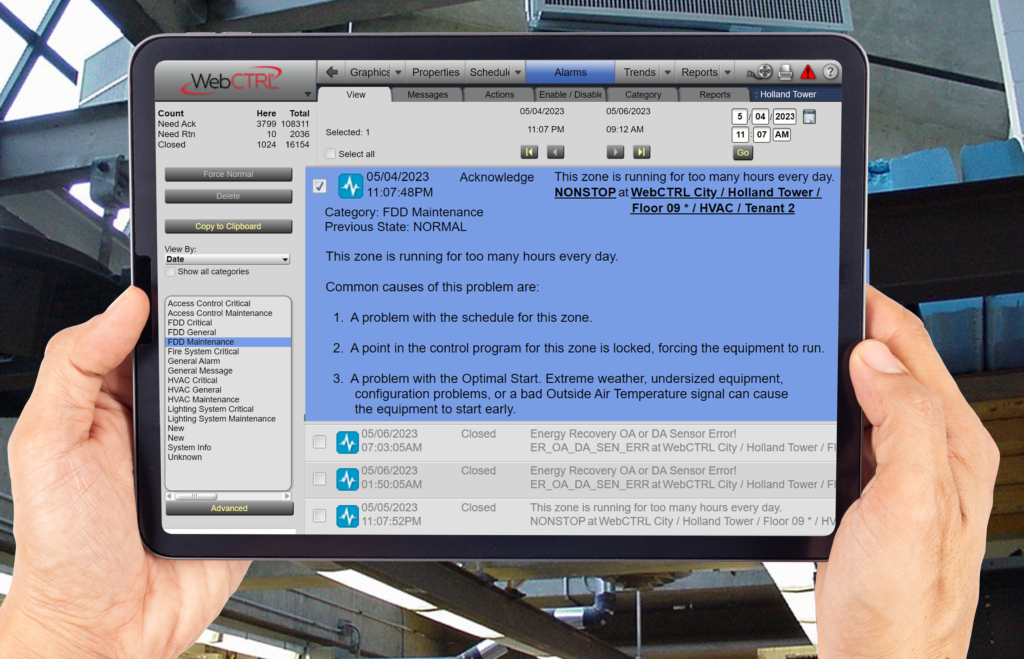The city was bustling with activity as the sun rose over the horizon, casting a warm glow on the buildings that towered over the streets below. Amongst these towering structures, building owners and facility managers were already hard at work, ensuring that their buildings were running at peak performance. But with so many systems to manage and maintain, it was a daunting task. HVAC, lighting, and other building systems all required constant attention, and the costs of maintaining them could add up quickly.
That’s where ASHRAE Guideline 36 Fault Detection and Diagnostics (FDD) comes in. By using data analytics to identify and diagnose issues in a building’s systems, FDD could help building owners and facility managers achieve numerous benefits, including increased energy efficiency, reduced maintenance costs, improved occupant comfort, and increased equipment lifespan.
Increased Energy Efficiency
One of the primary advantages of implementing ASHRAE Guideline 36 FDD is increased energy efficiency. FDD algorithms can analyze large amounts of data from a building’s systems and identify inefficiencies, such as equipment operating outside of optimal parameters, malfunctioning equipment, or equipment that needs to be serviced or replaced. By identifying and addressing these inefficiencies, building owners and facility managers can reduce energy consumption and save money on energy costs.
For example, a study conducted by the Department of Energy’s Pacific Northwest National Laboratory found that implementing FDD in commercial buildings resulted in energy savings ranging from 10% to 30%. These energy savings are achieved by identifying and correcting issues that lead to energy waste, such as equipment operating during unoccupied hours, duct leaks, and inefficient temperature setpoints.
Reduced Maintenance Costs
Another advantage of implementing ASHRAE Guideline 36 FDD is reduced maintenance costs. By identifying issues in a building’s systems early on, facility managers can address them before they become more serious and expensive to fix. For example, if a building’s air handling unit is operating at suboptimal levels due to a clogged filter or a malfunctioning motor, FDD algorithms can identify the issue before it causes the equipment to fail completely. By addressing the issue early on, facility managers can avoid costly emergency repairs and replacement costs.
Additionally, FDD algorithms can provide facility managers with data-driven insights into the health of a building’s systems, allowing them to identify trends and proactively address issues before they lead to downtime or equipment failure. By addressing issues before they become serious, facility managers can reduce maintenance costs and extend the lifespan of their building’s systems.
FDD can also identify issues with a building’s water systems. By analyzing data from sensors and valves, FDD can detect leaks or other issues with the building’s HVAC and plumbing systems. This not only reduces maintenance costs, but it also helps prevent water damage and reduces water consumption.
Improved Occupant Comfort
Implementing ASHRAE Guideline 36 FDD can also improve occupant comfort. FDD algorithms can identify issues in a building’s HVAC, lighting, and other systems that may be causing discomfort for building occupants. For example, if a building’s temperature is fluctuating too much or if the air quality is poor, FDD algorithms can identify the issue and provide facility managers with recommendations for addressing the issue.
But why is occupant comfort so important? There are several reasons. First and foremost, a comfortable environment can lead to higher tenant satisfaction. If building occupants are uncomfortable, they’re more likely to complain to building management or look for another building to occupy. Additionally, a comfortable environment can lead to increased productivity. When occupants are comfortable, they’re able to focus better on their work and may be less likely to take breaks or leave the building early.
But it’s not just about temperature and air quality. Lighting is also a critical component of occupant comfort. Poor lighting can lead to eye strain, headaches, and reduced productivity. By using FDD algorithms to identify lighting issues, facility managers can ensure that occupants are able to work in a well-lit environment that’s conducive to productivity and comfort.
Increased Equipment Lifespan
Finally, implementing ASHRAE Guideline 36 FDD can increase the lifespan of a building’s systems. By identifying and addressing issues early on, facility managers can prevent equipment from operating outside of optimal parameters or failing completely. This can lead to longer equipment lifespans and reduced replacement costs.
For example, if a building’s chiller is operating at suboptimal levels due to a malfunctioning component, FDD algorithms can identify the issue before it causes the chiller to fail completely. By addressing the issue early on, facility managers can avoid costly emergency repairs and replacement costs. Additionally, by identifying trends and proactively addressing issues, facility managers can extend the lifespan of their building’s systems, reducing the need for replacement and lowering long-term costs.
In the screenshot example below from a WebCTRL system, the Fault Detection analytics reveals a critical issue with the zone: it has been running for excessive hours each day. Fortunately, the FDD system goes beyond just identifying the problem; it lists the most common causes. This information empowers maintenance technicians to address the issue more efficiently, saving labor and ensuring that the equipment receives proper and timely maintenance. Overall, this helps maintain the system’s optimal performance and prevent costly repairs or replacements down the line.

Conclusion
In conclusion, implementing ASHRAE Guideline 36 FDD can provide numerous benefits for building owners and facility managers. By using data analytics to identify and diagnose issues in a building’s systems, facility managers can achieve increased energy efficiency, reduced maintenance costs, improved occupant comfort, and increased equipment lifespan. Whether you’re managing a commercial building, a hospital, or a university campus, ASHRAE Guideline 36 FDD can help you achieve your maintenance and sustainability goals. So why wait? Start exploring the benefits of ASHRAE Guideline 36 FDD today.
Additional Resources
ASHRAE GUIDELINE 13-2015, SPECIFYING BUILDING AUTOMATION SYSTEMS
A guidance document to design, document, and specify building automation systems (BASs) with recommendations for good practice, project considerations, and detailed design options.
LinkedIn Group: High-Performance Sequences of Operation for HVAC Systems | GL36 | FDD
Introduction to and discussion of “High-Performance Sequences of Operation for HVAC Systems,” as described in ASHRAE Guideline 36-2018. This guideline defines best-in-class operation sequences for HVAC systems that help maximize energy efficiency, improve occupant comfort, and provide real-time FDD.
Poorly installed or maintained HVAC systems can lead to equipment operational issues, called faults, which can cause increased energy use and repair/maintenance costs, as well as lead to occupant comfort issues. Automated fault detection and diagnostics (AFDD) systems monitor data points in HVAC equipment (e.g., flows, temperatures, pressures, control signals) in real-time and apply a set of rules to identify equipment operational issues and their underlying causes.
Articles
Why ASHRAE Guideline 36 is so important
This article discusses the importance of ASHRAE Guideline 36, which provides recommendations for maintaining HVAC systems in healthcare facilities. It highlights the need for proper maintenance to prevent the spread of airborne pathogens and maintain IAQ for the health and safety of patients, staff, and visitors.
Will ASHRAE Guideline 36 help the U.S. catch up to the rest of the world?
The article discusses the potential benefits of the ASHRAE Guideline 36, which aims to improve the commissioning of building systems. The article suggests that implementing this guideline could help the United States catch up to other countries in terms of energy efficiency and sustainability in building design.
ASHRAE Guideline 36 and FDD systems are valuable tools for building owners and operators. Implementing these systems can bring numerous benefits, such as improving energy efficiency, increasing equipment lifespan, enhancing occupant comfort and indoor air quality, improving building performance, reducing maintenance costs, complying with building codes and standards, and increasing occupant satisfaction.
This technical article discusses a deep dive simulation, including calculations, of ASHRAE Guideline 36-2018 prescribed high-performance sequences of operation for the VAV airside systems.
Videos
YouTube Webinar: ASHRAE Guideline36: Updates and Keys to Specifying
ASHRAE Guideline 36 – High-Performance Sequences of Operation for HVAC Systems – Steve Taylor



